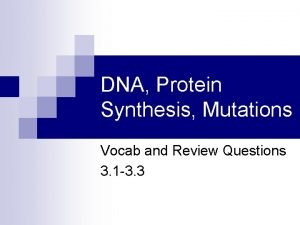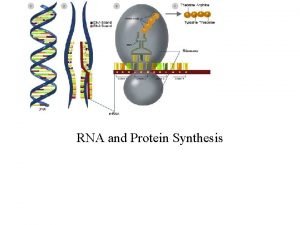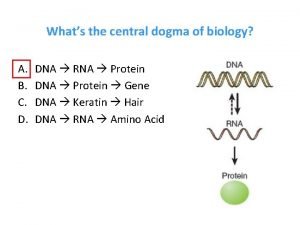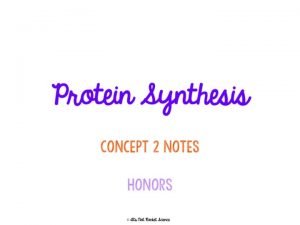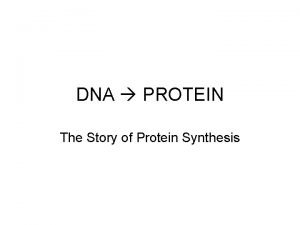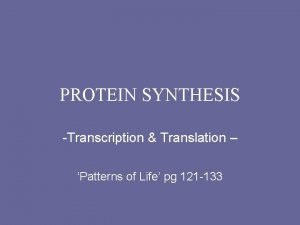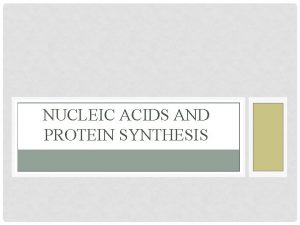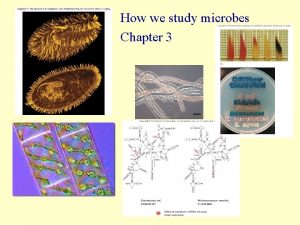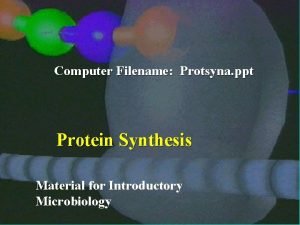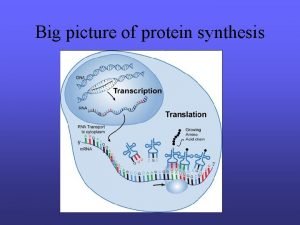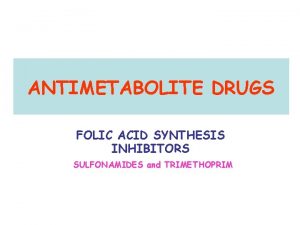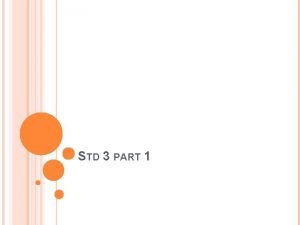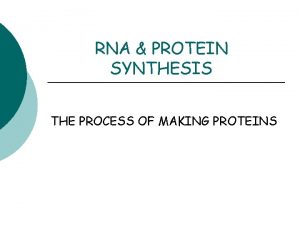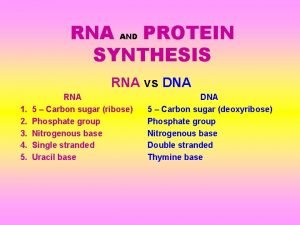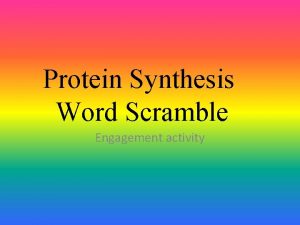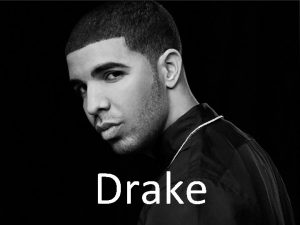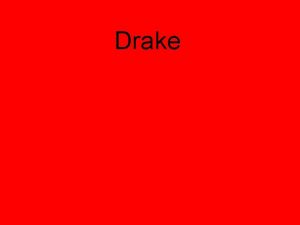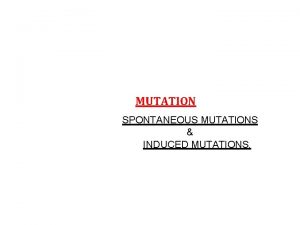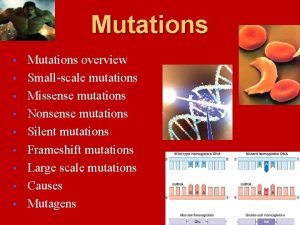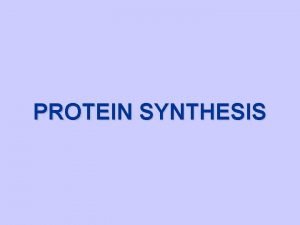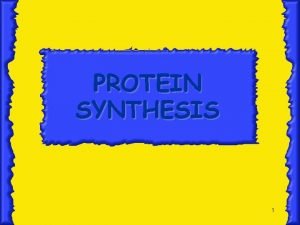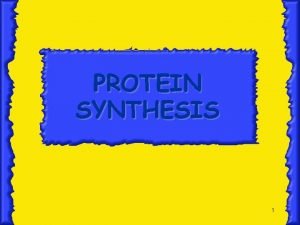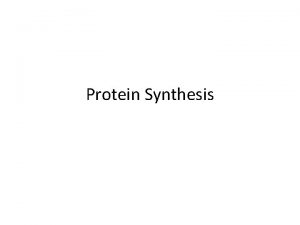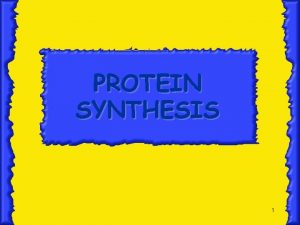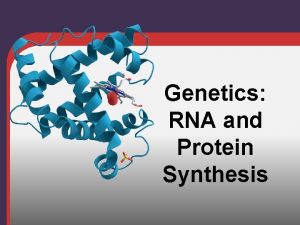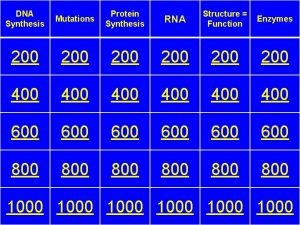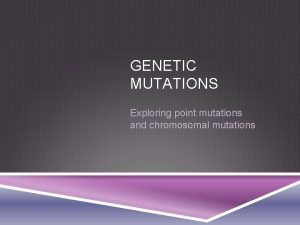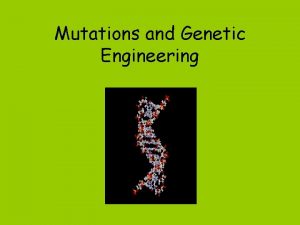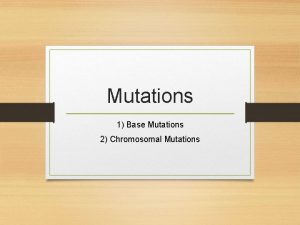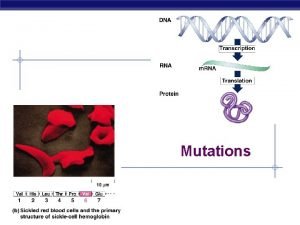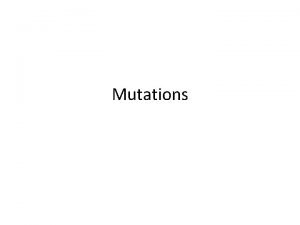Mr Drake PROTEIN SYNTHESIS AND MUTATIONS Review Questions




























- Slides: 28

Mr. Drake PROTEIN SYNTHESIS AND MUTATIONS

Review Questions What organelle makes proteins? Where do these organelles get their directions? What are the monomers of proteins? Can mistakes occur in the DNA? What are those mistakes called? What are the two different types of nucleic acids? What are the monomers of nucleic acids?

DNA Replication DNA is in the form of a double-helix DNA gets split and each old strand of DNA acts as a template to make a new strand of DNA. This is known as semiconservative replication.

Protein Synthesis occurs in four steps: Transcription – DNA is copied into m. RNA is edited m. RNA leaves the nucleus Translation – m. RNA is read and a protein is made

What is RNA? RNA is different from DNA in 3 ways 1) The sugar in RNA is Ribose where in DNA it is Deoxyribose ▪ RNA = Ribonucleic acid 2) RNA is usually single stranded; DNA is double stranded 3) RNA includes the nucleotide Uracil INSTEAD of Thymine ▪ A – U G-C

3 types of RNA Messenger RNA (m. RNA) Carries the genetic code from the DNA, out of the nucleus, to the ribosomes Ribosomal RNA (r. RNA) RNA found inside of the ribosomes that make up their structure Transfer RNA (t. RNA) RNA that carries the amino acids into the ribosomes to make a protein

Protein Synthesis Step 1: Transcription-Copy DNA into m. RNA Step 2: Unimportant parts of m. RNA (introns) get taken out of m. RNA Step 3: m. RNA leaves the nucleus and goes to the ribosomes Step 4: Ribosomes read the m. RNA and hook on the correct amino acid

Step 1 - Transcription Copy DNA into m. RNA DNA is opened up RNA polymerase hooks onto DNA Makes complementary strand of m. RNA ▪ A hooks to T ▪ U hooks to A ▪ G hooks to C

Step 2: Unimportant parts of m. RNA are removed Introns (unimportant parts of m. RNA) are removed Exons are spliced back together

Step 3: m. RNA leaves the Nucleus and goes to a ribosome

Step 4: Translation Ribosomes hook onto the m. RNA and read the m. RNA code in groups of 3 nucleotides Codons-groups of 3 nucleotides t. RNA anticodon matches up with a START codon (AUG) on the m. RNA sequence and t. RNA begins to bring in the correct amino acids

Amino acids hook together by peptide bonds Codons are read until a stop codon is reached

20 possible amino acids Codons code for one of 20 amino acids Proteins that are formed are based on the amino acid sequence

m. RNA-AUGCUAGGCCCA Figure out the order of amino acids using the m. RNA strand above

Do the whole process! DNA: TTAGCGAATTCA m. RNA: Amino Acids:

To RECAP The DNA is opened up by RNA polymerase and the DNA is transcribed into m. RNA. Unimportant pieces of RNA called introns are removed from the m. RNA, and the exons are spliced together. The m. RNA leaves the nucleus and binds to a ribosome in the cytoplasm. The ribosome reads that m. RNA code in groups of 3 called codons, and t. RNA hooks on the correct amino acids that is coded for. Once a stop codon is read, the polypeptide chain is released and a new protein is formed.

Mistakes can OCCUR!!! Mistakes in the DNA are known as mutations. Not all mutations are necessarily bad, but many are detrimental (harmful) Two Types of Mutations ▪ Chromosomal mutations-large pieces of the DNA ▪ Gene mutations-Individual nucleotide errors

Chromosomal Mutations Deletion – loss of a piece of chromosome Duplication – an extra piece of an already existing piece chromosome is produced Inversion – the direction of parts of chromosome are reversed Translocation – when part of a chromosome breaks off and attaches to a different chromosome

Chromosomal Mutations

Chromosomal mutation. Nondisjuction Nondisjunction- the failure of a chromosome to separate from its homologous pair during gamete formation in meiosis.

Nondisjunction in Real Life Ex: Klinefelter’s syndrome-caused by the nondisjuction of the XX chromosomes during egg formation, causing the boy to end up with XXY

Gene Mutations Point Mutations – gene mutations involving in one or a few nucleotides. 1) Silent Mutation 2) Nonsense Mutation 3) Frameshift Mutation 4) Missense Mutation

1) Silent Mutations Single nucleotide changes in the DNA sequence. This nucleotide error, however, does not make a difference because the codon still codes for the same amino acid as it would have before.


2) Nonsense Mutations Point mutation in a DNA sequence that causes a premature stop codon. This results in an incomplete protein which usually cannot complete its function.

3) Frameshift Mutation If a nucleotide is added or deleted, the bases are still read in groups of three, but now those groupings are shifted for every codon that follows. By shifting the reading frame, frameshift mutations may change every amino acid that follows the point of the mutation.

4) Missense Mutations Mutation that occurs in an amino acid codon which results in the use of a different, but sometimes chemically similar, amino acid. The similarity between the two is enough that little or no change is often rendered in the protein structure.

Sickle Cell Anemia Sickle cell anemia is an example of a missense mutation that DOES change the protein Substitutes A for T. Results in a defective form of the protein hemoglobin (carries oxygen in the red blood cells(, causing the cells to be sickle shaped.
 4 steps of protein synthesis
4 steps of protein synthesis Protein synthesis and mutations
Protein synthesis and mutations Protein synthesis and mutations
Protein synthesis and mutations Section 12-3 rna and protein synthesis answer key
Section 12-3 rna and protein synthesis answer key Rna and protein synthesis study guide
Rna and protein synthesis study guide Rna transfer
Rna transfer Rna protein synthesis
Rna protein synthesis Protein synthesis
Protein synthesis Restaurant analogy
Restaurant analogy Transcription and translation
Transcription and translation Protein synthesis gcse
Protein synthesis gcse Cookie monster analogy
Cookie monster analogy Whats the central dogma of biology
Whats the central dogma of biology Rna types
Rna types Protein synthesis
Protein synthesis Protein synthesis
Protein synthesis Synthesis
Synthesis Protein synthesis animation mcgraw hill
Protein synthesis animation mcgraw hill Test cross definition
Test cross definition Transcription and translation
Transcription and translation Protein synthesis
Protein synthesis Riosome
Riosome Protein synthesis ppt
Protein synthesis ppt Picture of protein synthesis
Picture of protein synthesis Sulfonamides mechanism of action
Sulfonamides mechanism of action Which best summarizes the process of protein synthesis?
Which best summarizes the process of protein synthesis? Concept map of protein synthesis
Concept map of protein synthesis Protein synthesis
Protein synthesis Protein synthesis scramble
Protein synthesis scramble


